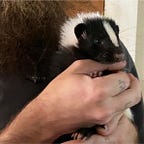What You Need To Know About Coyotes (Canis Latrans)
What comes to mind when you hear the word “Coyote”? For some, it’s a large and vicious monster, even bigger than a wolf. For others, it’s a ruthless predator that stalks neighborhood pets and children. But what are coyotes, truly? I’m here to tell you that they’re not the vicious monsters some think they are. So let’s debunk some myths, and some half truths, that have been fueled by generations of misinformation.
Coyotes aren’t big.
Coyotes average 30 pounds in weight. That’s smaller than your average retriever. Alphas can err on the larger side and have weighed in at around 44 pounds but compared to a retriever that’s still fairly small.
Coyotes don’t pose much of a threat to humans
There have been documented instances where coyotes have attacked, and even killed, humans. They are still wild animals and can be dangerous. But coyote attacks on humans are relatively low compared to attacks by other animals. This is due in part to the fact that we don’t usually live alongside coyotes like we do other animals, such as dogs. In rural areas if you see a coyote, chances are you’re seeing it’s hind end as it runs off, or you’re seeing it off in the distance. This is because rural coyotes see humans as a threat, and thus are more inclined to be skittish. Urban coyotes, on the other hand, have learned to live alongside humans and have shed a lot of their fear of them. As we expand our habitats, we also drive away their competition: wolves. So coyotes have found opportunities for prey in urban environments and often times it’s illegal to discharge firearms inside of city limits, or illegal to hunt any animals inside city limits, making it a much safer environment for them. But what should you do if you see a coyote in either a rural or urban environment? For rural areas, if the coyote is off in the distance digging for mice or other food sources, you should leave them alone. They’re simply doing what we want them to do in the first place. But if you’re face to face with them, stand tall and make yourself big. Lock eyes with them. Make loud noises, such as shouting, whistling, ringing a bell, etc. The louder you are the better. NEVER turn your back and try to run away. This can cause them to see you as prey. Instead, back away slowly while maintaining eye contact and making noise. More often than not they will run off.
Some ways to reduce their presence in your area could be by keeping your pets inside and supervising them outside. Clean up dog poop in your yard as they can smell it over large areas and may see that as competition. Don’t leave fallen fruits laying in the yard and don’t feed your pets outside. Additionally you can install an 8 foot fence around your property to make it harder for them to get in.
Removing coyotes attracts more coyotes.
If you’re living in an urban environment, and you see a coyote that isn’t really causing any problems, it’s best to leave it alone. By removing one another will just come take its place. And the replacement might be more aggressive and problematic. If the coyote is being an issue, call your local fish and wildlife office or department of natural resources to come handle the situation. Do NOT try to remove them yourself. If you’re located in a state where coyotes can be possessed by permitted or licensed professionals, you can try keeping a list of numbers for people who will come relocate them. But remember: if it’s not problematic, it’s best to just leave it alone.
Coyotes aren’t after your children.
This doesn’t mean your children are safe around coyotes, or any wildlife for that matter. But coyotes don’t wake up and actively seek out your children, either. Instead, supervising small children who are outside is your safest option. If you see a coyote sneaking around where your child is playing, you can quickly pick him or her up and follow the above mentioned method of scaring them off. And I should take this moment to say that this may be harder between April and August, when mothers give birth to their pups and become very protective over them. For parents that have older children, teaching them about situational awareness and the methods of scaring off coyotes could save them from a possible bad encounter with one.
Coyotes look for easy meals.
Coyotes will eat just about anything. And that includes small pets. If you’re concerned that one might eat your cat, or small dog, keep them indoors and only let them out while under supervision. Anything that could be considered food should be picked up. This includes bird seed, which attracts rodents. Rodents are easy targets for coyotes.
Coyotes are important
Many people view them in a negative manner. Some of which may stem from a negative encounter. That is okay. I’m not here to tell you how to feel about them, but simply to shed some light on the many misconceptions so that you might not be as afraid. Coyotes help manage other nuisance wildlife. For example: they will hunt raccoons, who can cause damage to property as well as spread disease. Without coyotes we would see an explosion in other wildlife, especially ones we don’t usually want freely roaming around our homes. Unless, of course, you’re into that kind of thing like I am.
I thank you for taking the time to read some of these common misconceptions about coyotes and hope that you enjoyed it, and maybe learned something new. You can always check out Frau Holle Wildlife & Exotics Rescue on Facebook for exciting content going forward. Stay tuned and stay safe!
